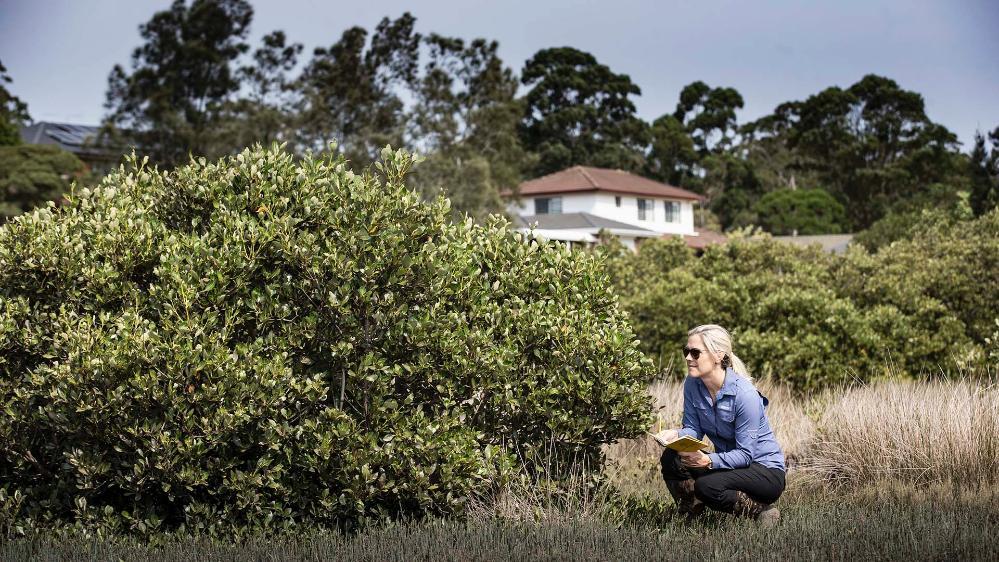September 4, 2023
Coastal habitats threatened by rising seas, temperatures
Global research sounds the alarm on habitat destruction due to climate change
Research published this week in Nature titled Widespread retreat of coastal habitat is likely at warming levels above 1.5 °C warns that coastal habitats such as mangroves, tidal marshes and reefs are in severe danger from rising sea levels and climbing temperatures.
A team of international researchers including University of Wollongong’s (UOW) Professor Kerrylee Rogers, Dr Jeffrey Kelleway and Professor Colin Woodroffe looked at historical evidence of sea-level rise at the end of the last Ice Age around 17,000 years ago and found a rapid rise in sea levels had a devastating effect on coastal habitats and recovery took thousands of years.
The planet is at risk of a similar rise in sea levels again if warming levels rise above Paris Agreement targets of 1.5 – 2.0 degrees Celsius.
Professor Rogers, who’s research has focussed on coastal ecosystems of Australia for more than 20 years, said, “We are at a decision-making precipice; coastal habitats can likely adapt to some degree of rising sea levels, but if we do not take urgent action to mitigate climate change, the capacity for coastal ecosystems to adapt to warming greater than two degrees will be limited.
“This will have potentially devastating impacts on the extent of coastal ecosystems and the benefits that they provide to humans, including coastal protection, fisheries and wildlife habitat, nutrient cycling, carbon storage and tourism activities.”
Mangroves and tidal marshes function as a significant carbon sink, often referred to as ‘blue carbon’, by absorbing carbon dioxide from the atmosphere. These coastal ecosystems possess inherent mechanisms to adjust to rising sea levels – but only up to a point.
“Coastal ecosystems exist where our oceans meet the land, including mangroves, coastal marshes and the fringes of sandy coral islands – the low-lying areas flooded and drained by tidal salt water,” said the study’s lead author, coastal wetlands specialist Professor Neil Saintilan from Sydney’s Macquarie University.
“Our research shows these coastal habitats can likely adapt to some degree of rising sea levels but will reach a tipping point beyond sea-level rises triggered by more than 1.5 to 2°C of global warming.
“Without mitigation, relative sea-level rises under current climate change projections will exceed the capacity of coastal habitats such as mangroves and tidal marshes to adjust, leading to instability and profound changes to coastal ecosystems.”
The scientists analysed the conversion of coastal ecosystems to open water and reviewed how they adapted to sea level rise following the last Ice Age.
The Paris Agreement's central aim is to strengthen the global response to the threat of climate change by keeping a global-temperature rise this century well below 2°C above pre-industrial levels, and to pursue efforts to limit the temperature increase even further to 1.5°C.
Abstract
Widespread retreat of coastal habitat is likely at warming levels above 1.5°C
www.nature.com/articles/s41586-023-06448-z
Several coastal ecosystems, most notably mangroves and tidal marshes, show biogenic feedbacks facilitating adjustment to relative sea-level rise (RSLR), including the sequestration of carbon and the trapping of mineral sediment. The stability of reef-top habitats under RSLR is similarly linked to reef-derived sediment accumulation, and the vertical accretion of protective coral reefs. The persistence of these ecosystems under high rates of RSLR is contested.
Here we show that the probability of vertical adjustment to RSLR inferred from palaeo-stratigraphic observations align with contemporary in situ survey measurements.
A deficit between tidal marsh and mangrove adjustment and RSLR is likely (P=0.67) at 4 mm yr-1 of RSLR, and very likely (P=0.9) at 7 mm yr-1 of RSLR. As rates of RSLR exceed ~7 mm yr-1, it becomes likely that reef islands destabilise through increased shoreline erosion and wave-overtopping. Increased warming from 1.5°C to 2.0°C would double the area of mapped tidal marsh exposed to 4 mm yr-1 of RSLR by 2080-2100.
At 3°C of warming, nearly all the world’s mangrove forests and coral reef islands and 40% of mapped tidal marshes are estimated to be exposed to RSLR ≥ 7 mm yr-1.
Meeting the Paris agreement targets minimises disruption to coastal ecosystems.
Author List
- Neil Saintilan: Macquarie University, corresponding author
- Benjamin Horton: Nanyang Technological University
- Torbjorn Tornqvist: Tulane University
- Erica Ashe: Rutgers University
- Nicole Khan: University of Hong Kong
- Mark Schuerch: University of Lincoln
- Chris Perry: University of Exeter
- Robert Kopp: Rutgers University
- Greg Garner: Rutgers University
- Nicholas Murray: James Cook University
- Kerrylee Rogers: University of Wollongong
- Simon Albert: The University of Queensland
- Jeffrey Kelleway: University of Wollongong
- Timothy Shaw: Nanyang Technological University
- Colin Woodroffe: University of Wollongong
- Catherine Lovelock: The University of Queensland
- Madeline Goddard: Charles Darwin University
- Lindsay Hutley: Charles Darwin University
- Katya Kovalenko: University of Minnesota-Duluth
- Laura Feher: U.S. Geological Survey
- Glenn Guntenspergen: US Geological Survey
